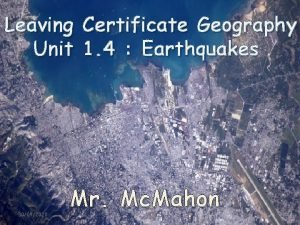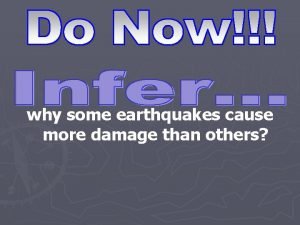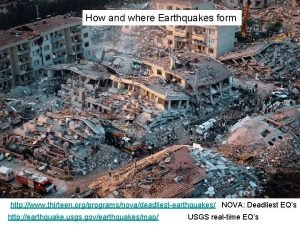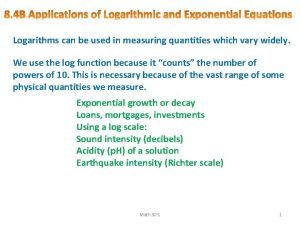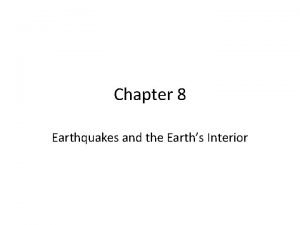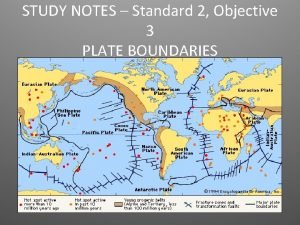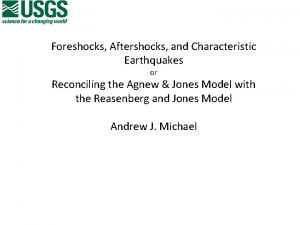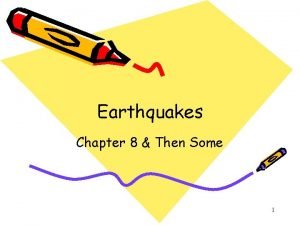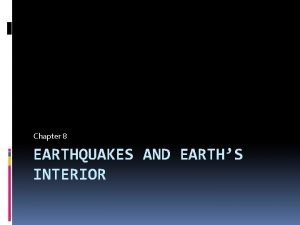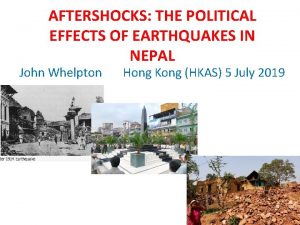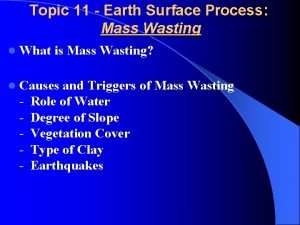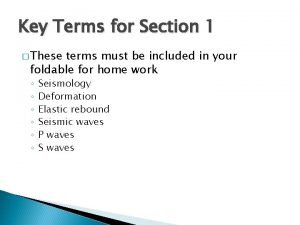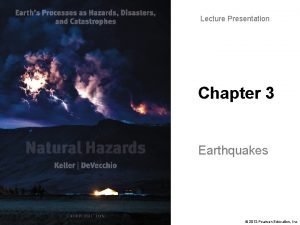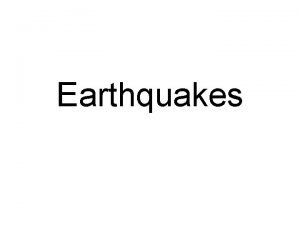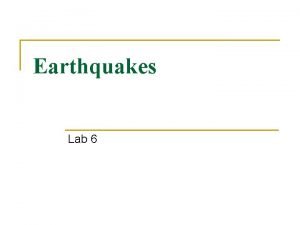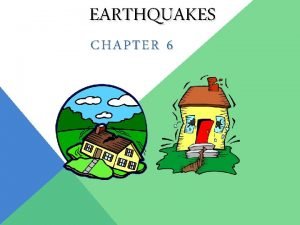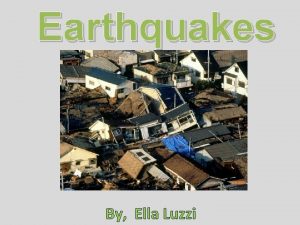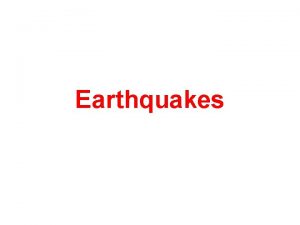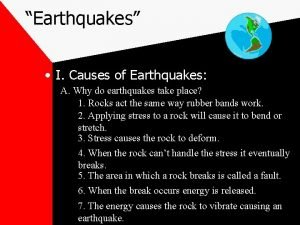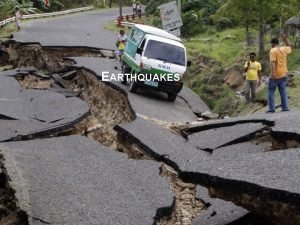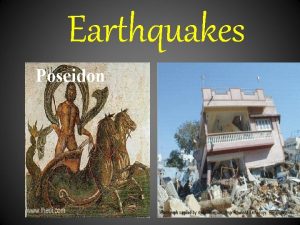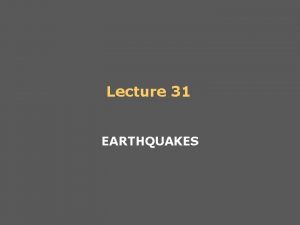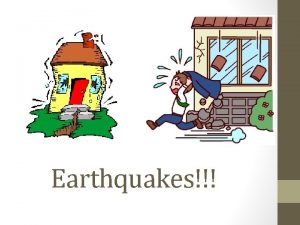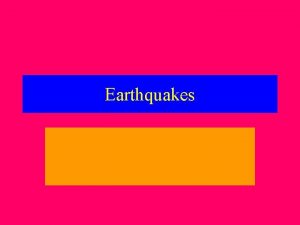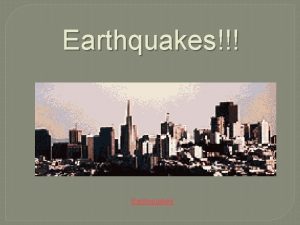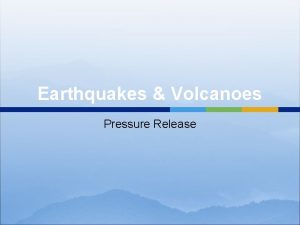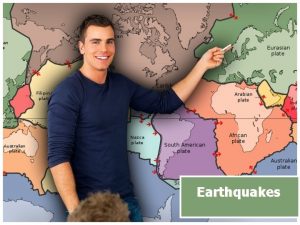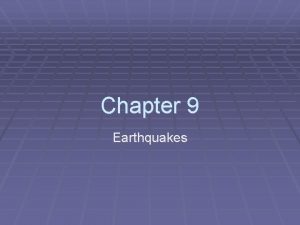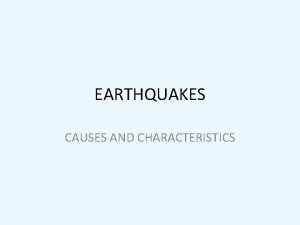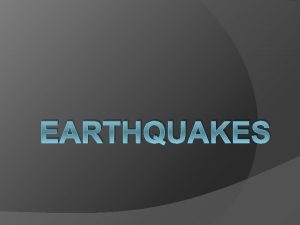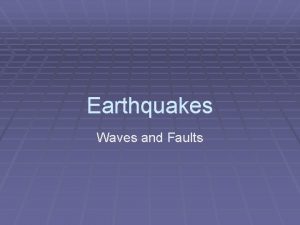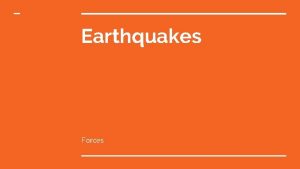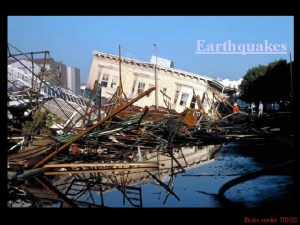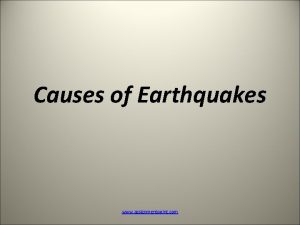Earthquakes I Causes of Earthquakes A Why do




























- Slides: 28

“Earthquakes” I. Causes of Earthquakes: A. Why do earthquakes take place? 1. Rocks act the same way rubber bands work. 2. Applying stress to a rock will cause it to bend or stretch. 3. Stress causes the rock to deform. 4. When the rock can’t handle the stress it eventually breaks. 5. The area in which a rock breaks is called a fault. 6. When the break occurs energy is released. 7. The energy causes the rock to vibrate causing an earthquake.

B. There are three factors that cause breakage in rock. 1. Compression - stress that squeezes rock layers together. 2. Tension - stress that stretches rock layers apart. 3. Shear - stress that causes the rock layers to slide by each other. C. Each one of these forces will cause a different fault. 1. Reverse Faults- Compression stress cause this type of fault 2. Normal Fault- Tension stress cause this type of fault. 3. Strike-Slip Faults - Caused by shear stress. A. ) Rocks move sideways past each other. B. ) San Andreas Fault in California is this type. 12/12/2021 Template copyright www. brainybetty. com 2005 2

II. Earthquake Energy: A. When rock breaks, energy is released as a seismic wave. 1. Seismic Wave - Energy wave that moves outward, in every direction, form the center of the earthquake. 2. Epicenter - is the point on the earth’s surface directly above the earthquake center. • III. Types of Seismic Waves: A. There are three types of seismic waves. 1. Primary Waves (P waves) - Energy waves that move through the ground in a back and forth motion. 12/12/2021 Template copyright www. brainybetty. com 2005 3

12/12/2021 Template copyright www. brainybetty. com 2005 4

Examples of P waves: A. ) Pushing down on your car and then letting go. B. ) A slinky. * P waves are the fastest moving earthquake waves. (6 km/s). 2. Secondary Waves (S Waves) - Move through the ground in an up and down motion. Examples: A. ) teeter- totter, or seesaw. * S waves move half as fast as P waves. (3 km/s) 12/12/2021 Template copyright www. brainybetty. com 2005 5

Seismic Waves Cont. 3. Surface Waves (L Waves) - Energy waves that travel along the surface of the earth like waves do in the ocean. (Rolling motion) * L waves move the slowest. (1 km/s) * Cause the most damage during an earthquake. 12/12/2021 Template copyright www. brainybetty. com 2005 6

12/12/2021 Template copyright www. brainybetty. com 2005 7

Tsunamis: A. What is a tsunami? 1. Tsunami - An earthquake generated ocean wave. B. How do they form? 1. An earthquake, landslide, volcanic eruption, or meteorite impact releases energy. 2. If in the ocean, the energy will push against the water, generating a powerful wave. 3. These waves can be from 30 to hundreds of feet high. 4. Most occur in the Pacific Ocean coast of South America. 12/12/2021 Template copyright www. brainybetty. com 2005 8

“Volcanoes” I. What is a Volcano? A. Volcano - A hole in the earth’s surface that often forms mountains from eruptions of lava and/ or volcanic ash. B. What causes a volcano? 1. Rock has to melt into magma. 2. Magma is forced upward because it is less dense than the rock layers around it. 3. When magma and other gases reach the surface it turns to lava or volcanic ash. 4. That forms the volcano.

C. Where do volcanoes occur? 1. A volcano can occur in one of three places. A. ) Rift Zone B. ) Subduction Zone C. ) “Hot Spots” 2. Divergent Plate Boundaries - The area where plates move apart. A. ) When plates move apart they form large cracks in the crust called rift zones. 12/12/2021 B. ) Lava flows out of the rift zone. C. ) This builds up a volcano. Template copyright www. brainybetty. com 2005 10

12/12/2021 Template copyright www. brainybetty. com 2005 11

12/12/2021 Template copyright www. brainybetty. com 2005 12

12/12/2021 Template copyright www. brainybetty. com 2005 13

Where volcanoes occur cont. D. ) Examples: Volcanoes of Iceland (On the Mid Atlantic Ridge). 3. Convergent Plate Boundaries - The area where plates collide into each other. A. ) When plates collide one plate is pushed downward. B. ) This area is known as a subduction zone. C. ) The heat and pressure of the plate being downward forms magma. 12/12/2021 Template copyright www. brainybetty. com 2005 14

Where volcanoes occur cont. D. ) A volcano forms when the magma reaches the surface. E. ) Examples: Ring of Fire volcanoes in the Pacific (Mt. St. Helens, Mt. Pinatubo). 4. Hot Spots - Areas of the mantle that are warmer than other areas. A. ) Rock melts in these areas. B. ) The magma reaches the surface and forms a volcano. C. ) Example: Hawaiian Islands. 12/12/2021 Template copyright www. brainybetty. com 2005 15

II. Eruptions & Volcanoes: A. What causes a violent eruption? 1. Two things determine if a volcano erupts violently or quietly. A. ) The amount of water and gas trapped in the magma. B. ) The type of magma. B. Amount of water and gases trapped: 1. Water and gases in magma act like soda in a can. 12/12/2021 Template copyright www. brainybetty. com 2005 16

B. Amount of water and gases trapped cont. 2. If you shake the can and open it the gases explode out of the can. 3. Gases in magma also try to escape. 4. When the gases escape the volcano explodes. After 12/12/2021 Template copyright www. brainybetty. com 2005 17

C. The Type of Magma: 1. Basaltic magma has a low viscosity. 2. Viscosity - The ability of a substance to flow or the silica content of magma. 3. Gases are released easily. 4. This causes nonviolent eruptions like Mt. Kilauea in Hawaii. 5. Granitic magma has a high viscosity. 6. Gases build up huge amounts of pressure before being released. 7. This causes violent eruptions like Mt. St. Helen's in Washington. 12/12/2021 Template copyright www. brainybetty. com 2005 18

D. Activity Levels: 1. Volcanoes have three activity levels. a). Active- A volcano that is erupting or it is showing signs that it may erupt in the near future. b. ) Dormant- A volcano that is not erupting, and not showing signs that it will anytime soon. It could be come active at any time. c. ) Extinct- A volcano that is no longer in an active volcanic zone. It has very little chance of ever becoming active again. 12/12/2021 Template copyright www. brainybetty. com 2005 19

E. Forms of Volcanoes: 1. The form depends on if it was a nonviolent or violent eruption. 2. There are three basic types: A. ) Shield Volcanoes B. ) Cinder Cone C. ) Composite 3. Shield Volcanoes - a broad volcano with gently sloping sides, built by nonviolent eruptions of basaltic magma. A. ) Example: Hawaiian Islands. 12/12/2021 Template copyright www. brainybetty. com 2005 20

Forms of Volcanoes Cont. 4. Cinder Cone - Volcano that forms from volcanic material that is violently erupted and piles up into a steep sided cone mountain. A. ) Tephra - lava and or other volcanic material that harden into ash, cinders or bombs. B. ) Example: Paricutin in Mexico (Corn Field Volcano). 5. Composite Volcano - Volcano that alternates between violent tephra eruptions and nonviolent lava eruptions. 12/12/2021 Template copyright www. brainybetty. com 2005 21

Forms of Volcanoes Cont. A. ) Composite volcanoes are the most violent. B. ) Example: Mt. St. Helens, Mt. Pinatubo. C. ) Pyroclastic Flows are very common. A dense, destructive mass of very hot ash, lava fragments, and gases ejected explosively from a volcano and typically flowing at great speed 12/12/2021 Template copyright www. brainybetty. com 2005 22

Mt. Kilauea 12/12/2021 Template copyright www. brainybetty. com 2005 23

Mt. Paricutin Mt. Etna Mt. Vesuvius 12/12/2021 Template copyright www. brainybetty. com 2005 24

Mt. Pinatubo 12/12/2021 Template copyright www. brainybetty. com 2005 25

Mt. Mauna Loa (Hawaii) 12/12/2021 Template copyright www. brainybetty. com 2005 26

Magma Chamber (Batholith)- a large underground pool of liquid rock found beneath the surface of the Earth Dike- a sheet of rock that cuts across a pre-existing rock body. Laccolith- Magma that has been injected between two layers of sedimentary rock. The pressure of the magma is high enough that the overlying rock layers are forced upward, giving the laccolith a dome or mushroom-like form. Sill- a sheet of rock that runs parallel to a pre-existing rock body. Xenolith- is a rock fragment which becomes enveloped in a larger rock during the latter's development and hardening. Central Vent- When pressure is strong enough magma shoots up through this primary vent. Fissure- Secondary magma vents. 12/12/2021 Template copyright www. brainybetty. com 2005 27

Structures Inside of a Volcano Structures of Igneous Rock. Legend: A = magma chamber (batholith); B = dyke/dike; C = laccolith; E = sill; F = stratovolcano; processes: 1 = newer intrusion cutting through older one; 2 = xenolith or roof pendant; 3 = contact metamorphism; 4 = uplift due to laccolith 12/12/2021 28 emplacement.
 Causes of earthquake in points
Causes of earthquake in points Causes of earthquake
Causes of earthquake Pictures
Pictures Why some earthquakes cause more damage than others
Why some earthquakes cause more damage than others Why do earthquakes occur
Why do earthquakes occur Proximate cause and ultimate cause
Proximate cause and ultimate cause Proximate and ultimate behavior examples
Proximate and ultimate behavior examples Dont ask
Dont ask In what section of earth do earthquakes happen?
In what section of earth do earthquakes happen? Btn earthquakes
Btn earthquakes Chapter 8 section 3 earthquakes and society answer key
Chapter 8 section 3 earthquakes and society answer key Hazard picture
Hazard picture Http://earthquake.usgs.gov/earthquakes/map/
Http://earthquake.usgs.gov/earthquakes/map/ Chapter 8 earthquakes and volcanoes
Chapter 8 earthquakes and volcanoes A large crack in the earth formed by a river or earthquakes
A large crack in the earth formed by a river or earthquakes Chapter 8 earthquakes and earth's interior
Chapter 8 earthquakes and earth's interior Chapter 19 earthquakes
Chapter 19 earthquakes Frequent earthquakes in an area may indicate *
Frequent earthquakes in an area may indicate * Earthquakes
Earthquakes Chapter 8 quiz 1
Chapter 8 quiz 1 Chapter 8 earthquakes and earth's interior
Chapter 8 earthquakes and earth's interior Earthquakes
Earthquakes Examples of mass movement
Examples of mass movement Elastic rebound theory
Elastic rebound theory Do earthquakes happen
Do earthquakes happen Pearson
Pearson The point on the ground directly above the focus
The point on the ground directly above the focus What types of earthquakes are there
What types of earthquakes are there Liquefaction occurs when seismic waves cause __________.
Liquefaction occurs when seismic waves cause __________.
